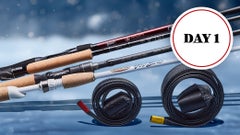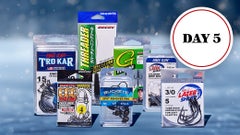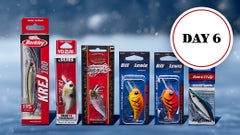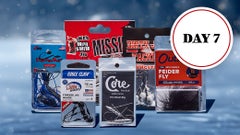Summer Night Casting Jig Patterns & Techniques
The casting jig is a weedless and highly versatile option for night fishing as it can be fished at any depth, virtually anywhere on the lake. With a big hook, bulky profile, and head that comes through a variety of structure, the casting jig mitigates some of the snagging issues that arise when you don’t always have the ability to know what you are going to be casting into or around. Target the same hard bottom, rock, and wooded areas you would throw your crankbaits or big worms but look for cleaner banks with sparse grass or brush to avoid snagging grass or getting hung up constantly.
Rods:
There are many factors to think about when choosing a rod to fish a casting jig at night, but generally speaking, sizing up your tackle for night fishing will greatly improve your success. That being said, you need a rod that can handle a bigger, bulkier casting jig. Look for a heavy jig rod or light-duty flipping stick with Medium Heavy to Heavy power in the 7’3” – 7’6” range. Many anglers prefer Fast tapers when using heavy fluorocarbon, so the rod can rapidly engage the backbone on a big hookset, while other anglers prefer a Moderate bend that loads up slightly slower and really drives the hook home. It really just comes down to preference.
Reels:
A high-speed casting reel will give you the speed to pick up line quickly so you can drive and set the hook when you get a bite on a slack line. Using a reel with a faster 7:1 – 8:1 gear ratio will let you reel down to your bite rapidly, and also help keep a good bend in the rod as you reel the fish back in. Look for a 100- to 200-size casting reel, so you have enough line capacity to make a long cast with large diameter lines. A reel with an external brake adjustment will also make it convenient to change the tension on the fly, so you don’t have to pop off the side plate when its dark outside.
Line:
At night you will not always be able to make the most accurate casts or know exactly what you are tossing into, so you want a line that can withstand the abuse of getting snagged or hung up. Fluorocarbon and braid are both great options since you don’t have to worry about bass seeing your line at night. You can generally use the same 12-20lb fluorocarbon line you would use during the day, but it’s also not a bad idea to increase the pound test you are using for a little extra security as long as it doesn’t affect casting. After the sun goes down, many anglers will also take advantage of the veil of night and tie directly to 30-50lb braid for the added strength and responsiveness of no-stretch fishing line.
Modifications & Rigging:
Bass predominantly use their lateral lines at night to track down their prey, so you want to use trailers that have a lot of action and move some water to grab their attention. After dark you want to use a jig trailer with appendages that kick and flutter as they move through the water column, so try using a big double tail grub, flapping style craw, or brush hog. A jig with a full-sized skirt and high strand count also helps create a larger profile that moves more water. Consider adding a single or double rattle band to the shank of your jig hook when fishing at night to include an audible element of attraction.
Tips & Tricks:
The casting jig is a great lure to slow down with once you have located a school of fish but can also be used to cover water with the correct retrieve. During the summer fish will be grouped up both deep and shallow, so consider using a slow and steady retrieve while maintaining bottom contact to comb through high percentage areas with efficiency. Experiment with exclusively using heavy jigs when night fishing to improve your feel and try using pork trailers or adding scent to your jig plastics to help you get a few extra bites. Don't forget to check your line and knots often and re-tie frequently when fishing at night.
Colors:
Selecting a color for your night fishing jig is pretty straightforward. Use dark shades and solid colors so the jig stands out against its surroundings. Black-and-blue or solid black will provide some added distinction and contrast that will help a fish track down your jig in low light conditions.
















































